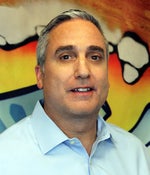 Credit: Dreamstime
Credit: Dreamstime
When the COVID-19 crisis bore down in mid-March, the IT team at Enova International diligently fired on all cylinders to convert the company to remote work, including standing up a contact center with nearly 700 employees. Powered by an initial adrenaline rush, employee engagement was high, and everyone banded together to maximize remote work.
Months into the pandemic, enthusiasm began to wane. Employees of the online financial services provider lamented the lack of physical connections to co-workers — not to mention access to an office environment flush with choice perks, from a 24/7 snack kitchen stocked with craft beers and curated wines to subsidized on-site manicures, massages, and haircuts. To sustain Enova’s employee-centered focus, the company had to figure out how to translate its physical perks and corporate culture into the virtual world to keep employees happy, engaged, and productive during what’s turned into a prolonged period of remote work.
Like Enova, all companies with a reputation as a great place to work in IT have had to reinvent their carefully crafted cultures for the new normal. Instead of catered dinners or drinks with colleagues working late nights, there are now virtual happy hours, cook-alongs, and Zoom wine and book clubs. Running, biking, and yoga clubs have morphed online, and that exercise or at-work gaming partner is now a virtual buddy.
Beyond finding ways to mimic watercooler engagement in an online space, organizations have also had to step up their game to ensure their collaborative cultures prevail and that the business of IT isn’t disrupted by new work patterns.
“We’ve had to get more creative with how to keep collaboration and engagement high,” says Joe DeCosmo, chief technology officer and chief analytics officer at Enova, ranked the No. 11 midsize organization on the 2020 Best Places to Work in IT list from Insider Pro and Computerworld. “We don’t have the great perks in the office available to use, but the culture is still the same — team members are super-empowered to manage their time and do their work, and we encourage innovation and creativity.”
Kitchen-table conversation
 Enova International, Inc.
Enova International, Inc.
“We’ve had to get more creative with how to keep collaboration and engagement high.” —Joe DeCosmo, CTO and CAO, Enova
One way Enova has sparked engagement in its ranks is through existing employee resource groups, such as those for women, Black and Latinx workers, which are working hard to create community and conversation. There have been regular meet-ups to talk about the issues of the day, including discussions around Juneteenth and other hot topics, DeCosmo says.
“Anything that drives everyone to talk about things you’d talk about at the lunch table or kitchen table — that’s been beneficial,” he adds.
At Veeam, ranked the No. 23 midsize company on this year’s Best Places to Work in IT list, the transition to a remote work environment was fairly painless, given that the backup software company has long operated more or less virtually without any real physical center of gravity, says Jim Kruger, the firm’s chief marketing officer. At the same time, however, the company’s HR department kicked into overdrive to come up with fun, engaging programs that would foster camaraderie.
Coffee roulette is one new option, where employees use a third-party app to be matched to others in the organization for a virtual get-to-know-you coffee break. There are online karaoke and trivia nights, video cooking exchanges, book clubs, and more.
“We’re trying to replicate hallway conversations, because we’re not having them,” Kruger says. “We’re trying to introduce people from different functions to create a more collaborative environment.”
Learning at a distance
Top IT organizations have also continued their training and career development efforts, often adapting them for a remote workforce.
 Veeam Software
Veeam Software
“We’ve [challenged] each other to come out of COVID-19 with at least one new area of expertise that we did not have prior to the pandemic.” —Jim Kruger, CMO, Veeam
Veeam employees have access to Skillsoft’s Percipio, an online learning platform that lets them choose from courses on a wide range of business tools, technologies and strategies. And the company has expanded its programs for employees to connect, seek and receive advice, including through a mentoring program in which employees set their own goals and learn from mentors in one-on-one relationships.
“Although teams are displaced remotely, we’ve continued to challenge each other to come out of COVID-19 with at least one new area of expertise that we did not have prior to the pandemic,” Kruger says. “We are all free to choose what that might be, and we’ve established a channel on Microsoft Teams where we can share interests, learnings, challenges, and be able to ask each other questions.”
At Enova, IT leaders made a decision to continue programs that have long been essential to the firm’s community and culture. For example, the company went forward with its summer internship program this year, albeit in virtual format, and kept alive its regular technology exchange where folks switch up jobs for a month to test-drive new roles and experiment with career moves.
The IT group also moved ahead with its technology fellowship and innovation program, which allows IT employees to propose new technology or research projects and, if selected, get time away from their day-to-day responsibilities to get the project done.
“The longer [the pandemic] goes on, the more we need to remember to do these things,” DeCosmo says.
Communication and flexibility are key
Now more than ever, communication at all levels of the organization is vital.
 Ultimate Software
Ultimate Software
“To focus on how everyone is doing physically, mentally, and engagement-wise, you really have to work at it.” —John Machado, CTO, Ultimate Software
At Ultimate Software, the No. 1 large organization on the Best Places to Work in IT list, there are a lot more virtual town hall meetings, and the monthly or quarterly leadership meetings have ramped up to a weekly cadence to provide additional Q&A time with executives and to give employees a chance to give feedback on what is and isn’t working, according to John Machado, chief technology officer at the HR software company.
The changes have also forced executives and department leaders to reach out more regularly to employees through formal meetings or impromptu discussions.
“You take for granted the connectedness of being in the same office and being able to walk around,” Machado explains. “Now, to focus on how everyone is doing physically, mentally, and engagement-wise, you really have to work at it.”
While more engagement and active communications are essential when IT colleagues aren’t co-located, employers have found that many employees need some help breaking free of work without the conventional guardrails of a traditional workday. At the same time, employees need additional flexibility and more breaks during the day to juggle their work schedules and more intense family obligations.
 Avanade Inc.
Avanade Inc.
“It’s vital that we give the flexibility so people can take care of themselves and their families.” —Bob Bruns, CIO, Avanade
Avanade, the No. 7 midsize company on this year’s Best Places list, considers its flexible work hours policy to be a fundamental part of its culture, one that has become even more important during the pandemic.
“It’s vital that we give the flexibility so people can take care of themselves and their families,” says CIO Bob Bruns. “As we look at the long view, continuing that flexibility will be key.”
At the end of the day, maintaining an environment that’s a great place to work when there is no brick-and-mortar workplace boils down to establishing trust through frequent, open, and direct communications.
“You have to make sure you’re being as transparent as possible throughout all of this,” says Enova’s DeCosmo. “People are dealing with a lot — from their health and wellness to whether their kids are going back to school or not. We just have to work really hard to keep those lines of communication open.”




